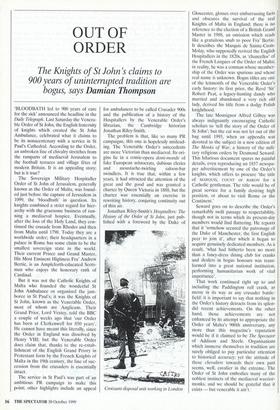OUT OF ORDER
The Knights of St John's claims to 900 years of uninterrupted tradition are bogus, says Damian Thompson
'BLOODBATH led to 900 years of care for the sick' announced the headline in the Daily Telegraph. Last Saturday the Venera- ble Order of St John, the English fraternity of knights which created the St John Ambulance, celebrated what it claims to be its nonacentenary with a service in St Paul's Cathedral. According to the Order, an unbroken line of chivalry stretches from the ramparts of mediaeval Jerusalem to the football terraces and village fetes of modern Britain. It is an appealing story; but is it true?
The Sovereign Military Hospitaller Order of St John of Jerusalem, generally known as the Order of Malta, was found- ed just before the capture of Jerusalem in 1099, the 'bloodbath' in question. Its knights combined a strict regard for hier- archy with the gruesome business of run- ning a mediaeval hospice. Eventually, after the loss of the Holy Land, they con- tinued the crusade from Rhodes and then from Malta until 1798. Today they are a worldwide order; their headquarters in a palace in Rome has some claim to be the smallest sovereign state in the world. Their current Prince and Grand Master, His Most Eminent Highness Fra' Andrew Bertie, is an Ampleforth-educated Scots- man who enjoys the honorary rank of Cardinal.
But it was not the Catholic Knights of Malta who founded the wonderful St John Ambulance or organised the jam- boree in St Paul's; it was the Knights of St John, known as the Venerable Order, most of whom are Anglicans. Their Grand Prior, Lord Vestey, told the BBC a couple of weeks ago that 'our Order has been at Clerkenwell for 850 years'. He cannot have meant this literally, since the Order in England was dissolved by Henry VIII; but the Venerable Order does claim that, thanks to the re-estab- lishment of the English Grand Priory in Protestant form by the French Knights of Malta in the 19th century, the line of suc- cession from the crusaders is essentially intact.
The service in St Paul's was part of an ambitious PR campaign to make this point; other highlights include an appeal for ambulances to be called Crusader 900s and the publication of a history of the Hospitallers by the Venerable Order's librarian, the Cambridge historian Jonathan Riley-Smith.
The problem is that, like so many PR campaigns, this one is hopelessly mislead- ing. The Venerable Order's antecedents are more Victorian than mediaeval. Its ori- gins lie in a comic-opera demi-monde of fake European aristocrats, dubious clerics and moustache-twirling saloon-bar swindlers. It is true that, within a few years, it had attracted the attention of the great and the good and was granted a charter by Queen Victoria in 1888, but the charter was essentially an exercise in rewriting history, conjuring continuity out of thin air.
Jonathan Riley-Smith's Hospitallers: The History of the Order of St John, just pub- lished with a foreword by the Duke of
Croissant disposal unit working in London Gloucester, glosses over embarrassing facts and obscures the survival of the real Knights of Malta in England; there is no reference to the election of a British Grand Master in 1988, an omission which reads like a gratuitous snub to poor Fra' Bertie. It describes the Marquis de Sainte-Croix- Molay, who supposedly revived the English Hospitallers in the 1820s, as 'chancellor' of the French Langues of the Order of Malta; in reality, he was a conman whose member- ship of the Order was spurious and whose real name is unknown. Bogus titles are one of the leitmotifs of the Venerable Order's early history: its first prior, the Revd 'Sir' Robert Peat, a legacy-hunting dandy who married and abandoned a very rich old lady, derived his title from a dodgy Polish knighthood.
The late Monsignor Alfred Gilbey was always indignantly encouraging Catholic scholars to 'tell the story of the Order of St John'; but the cat was not let out of the bag until 1995, when an appendix was devoted to the subject in a new edition of The Monks of War, a history of the mili- tary religious orders by Desmond Seward.
This hilarious document spares no painful details, even reproducing an 1857 newspa- per advertisement by one of the Order's knights, which offers to procure 'the title
of MARQUIS, COUNT Or BARON for a Catholic gentleman. The title would be of
great service for a family desiring high position, or about to visit Rome or the Continent.'
Seward goes on to describe the Order's remarkably swift passage to respectability, though not in terms which its present-day members would find flattering. He reports that it 'somehow secured the patronage of the Duke of Manchester, the first English peer to join it', after which it began to acquire genuinely dedicated members. As a result, 'what had hitherto been no more than a fancy-dress dining club for cranks and dealers in bogus honours was trans- formed into a great national institution, performing humanitarian work of vital importance'.
That work continued right up to and including the Paddington rail crash, as messy in its way as any crusader battle- field: it is important to say that nothing in the Order's history detracts from its splen- did recent achievements. On the other hand, those achievements are not enhanced by its attempt to appropriate the Order of Malta's 900th anniversary, any more than this magazine's reputation would be if it claimed to be The Spectator of Addison and Steele. Organisations which immerse themselves in tradition are surely obliged to pay particular attention to historical accuracy; yet the attitude of these chevaliers towards their own past seems, well, cavalier in the extreme. The Order of St John embodies many of the noblest instincts of the mediaeval warrior- monks, and we should be grateful that it exists — but venerable it ain't.


























































































 Previous page
Previous page